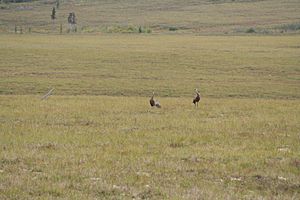Marshall, Alaska facts for kids
Quick facts for kids
Marshall
Masserculleq
|
|
|---|---|
| Country | United States |
| State | Alaska |
| Census Area | Kusilvak |
| Incorporated | June 9, 1970 |
| Area | |
| • Total | 4.06 sq mi (10.53 km2) |
| • Land | 4.06 sq mi (10.52 km2) |
| • Water | 0.00 sq mi (0.01 km2) |
| Elevation | 115 ft (35 m) |
| Population
(2020)
|
|
| • Total | 492 |
| • Density | 121.15/sq mi (46.78/km2) |
| Time zone | UTC-9 (Alaska (AKST)) |
| • Summer (DST) | UTC-8 (AKDT) |
| ZIP code |
99585
|
| Area code(s) | 907 |
| FIPS code | 02-47000 |
| GNIS feature ID | 1405984 |
Marshall (called Masserculleq in the Yup'ik language) is a small city in Alaska, United States. It is located in the Kusilvak Census Area, Alaska. In 2010, 414 people lived there. By 2020, the population grew to 492 people.
Contents
Geography of Marshall
Marshall is located in a part of Alaska called the Kusilvak Census Area. It covers about 10.5 square kilometers (4.06 square miles) of land. There is almost no water area within the city limits.
People and Population
This section talks about the people who live in Marshall. It looks at how many people live there and their backgrounds.
The population of Marshall has changed over time:
| Historical population | |||
|---|---|---|---|
| Census | Pop. | %± | |
| 1880 | 102 | — | |
| 1940 | 91 | — | |
| 1950 | 95 | 4.4% | |
| 1960 | 166 | 74.7% | |
| 1970 | 175 | 5.4% | |
| 1980 | 262 | 49.7% | |
| 1990 | 273 | 4.2% | |
| 2000 | 349 | 27.8% | |
| 2010 | 414 | 18.6% | |
| 2020 | 492 | 18.8% | |
| U.S. Decennial Census | |||
The first village in this area was called "Ooglovia" in 1880. It was an Inuit village. Later, in 1940, the area was known as Fortuna Ledge. In 1950, its name changed to Marshall.
The city was officially formed in 1970 as Fortuna Ledge. However, in 1984, the city changed its name back to Marshall. It has been called Marshall ever since.
In 2000, there were 349 people living in Marshall. Most people living in Marshall are Alaska Native or Native American. Some people are also White or have mixed backgrounds.
Many households in Marshall have children under 18. The average family size is about four people. The median age in the city was 22 years old. This means half the people were younger than 22 and half were older.
History of Marshall
Marshall was once known as Fortuna Ledge. It was a mining village in the 1800s and early 1900s. People mined for valuable minerals in a nearby area called Wilson Creek.
Many Alaska Natives moved to Fortuna Ledge from other villages. These villages included Unalakleet, Ohogamuit, and Takchak. Because of this, Marshall has two main Native groups. These are the Yup'ik people and the Inupiaq people.
Marshall also has people with Russian backgrounds mixed with Inupiaqs. This makes Marshall a community with Yup'ik, Inupiaq, and Russian roots. The city was reportedly named after Thomas Riley Marshall. He was the Vice-President of the United States from 1913 to 1921.
Education in Marshall
Students in Marshall attend Marshall School. This school teaches students from kindergarten through 12th grade. The Lower Yukon School District runs the school.
See also
 In Spanish: Marshall (Alaska) para niños
In Spanish: Marshall (Alaska) para niños



